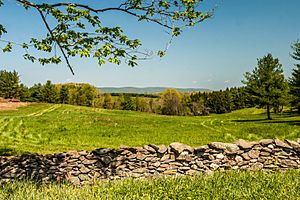Battle of Unison facts for kids
Quick facts for kids Battle of Unison |
|||||||
|---|---|---|---|---|---|---|---|
| Part of the American Civil War | |||||||
 The site of the battle in 2013 |
|||||||
|
|||||||
| Belligerents | |||||||
| Commanders and leaders | |||||||
| George McClellan | J.E.B. Stuart | ||||||
| Strength | |||||||
| Divisions | Brigade | ||||||
| Casualties and losses | |||||||
| ? | ? | ||||||
The Battle of Unison (also called the Battle of Union) was a series of small fights during the American Civil War. These battles happened in Loudoun County, Virginia, from October 31 to November 2, 1862. The fights were between Confederate cavalry led by J.E.B. Stuart and different parts of the Union Army of the Potomac.
Even though Stuart's troops were sometimes pushed back, he achieved his main goal. He managed to slow down the Union army. This gave the main Confederate army, the Army of Northern Virginia, time to move safely away.
Why the Battle Happened
After the Battle of Antietam, General Robert E. Lee and his Confederate Army of Northern Virginia moved back into Virginia. They went through the Shenandoah Valley. On October 10, 1862, J.E.B. Stuart and his cavalry rode around the Union army. This was his second "ride around" during the war. It was part of his Chambersburg Raid.
On October 12, Stuart finished his ride. He returned to Virginia through White's Ford in Loudoun County. He brought almost 1,200 captured horses with him. Stuart quickly moved through the county. He crossed over Snickers Gap into the Shenandoah Valley. His goal was to rejoin Lee's army.
On October 27, George B. McClellan and his Union Army of the Potomac finally entered Virginia. They were chasing Lee. They crossed the Potomac River near Berlin (now Brunswick, Maryland) and Harpers Ferry. The Union army then moved down the Loudoun Valley. They gathered food and supplies from local farms.
On October 30, Stuart returned to Loudoun County. He brought Brigadier General Fitzhugh Lee's soldiers and Major John Pelham's cannons. Their job was to scout the Union army's position. They also needed to hide the movements of the Confederate Army of Northern Virginia. This army was moving south of the Rappahannock River. After crossing the Blue Ridge into Loudoun County, Stuart's troops camped for the night in Bloomfield.
The Fights Begin
On October 28, Stuart's men rode towards Mountville. They had heard that Union soldiers were camped there. When they entered the village, the Confederates found about 100 Union soldiers. Stuart's troops surprised them and quickly defeated them. They killed or captured almost all of them.
The few Union soldiers who escaped rode quickly towards Aldie. The Confederates chased them closely. The chase stopped at Aldie. Here, Stuart's cavalry met a large group of Union soldiers defending the village. Union cannons on the hills west of town forced Stuart's troops back up the road.
Stuart did not give up. He soon brought up Pelham's cannons. Pelham's cannons were better than the Union ones. They eventually forced the Union cannons and other soldiers to leave Aldie. During the cannon fight, Stuart got a wrong report. He heard that Union soldiers were coming from Mountville to attack his rear. So, he stopped chasing the Union troops. Instead, he turned his force to face this "phantom" threat. When he realized it was a mistake, Stuart and his troops went back to Bloomfield. They left guards along the road to watch for the enemy.
The next morning, Union soldiers attacked Stuart's guards at Philomont. Stuart moved his troops east to Unison. This spot was important because it was where the main road crossed another major north-south road. By moving there, Stuart placed his troops between the Union forces and D.H. Hill's Confederate troops. Hill's troops were camped at Upperville. However, the Union soldiers did not attack for the rest of that day.
The next morning at 8 a.m., the Union army attacked Stuart's position. They used infantry (foot soldiers), cavalry, and cannons. Stuart cleverly had his soldiers get off their horses. They took cover behind many stone walls in Unison. He placed Pelham's cannons on the hills west of town. From these positions, Stuart's smaller force was able to hold out against a much larger Union force for most of the day.
Finally, as night came, the Union soldiers made a strong push. Stuart was forced to quickly retreat to Upperville. He had to leave his seriously wounded soldiers behind. Once safe at Upperville, Stuart planned to attack the Union forces again the next day. But his scouts soon reported that the entire Union Army was heading towards him. Stuart decided to cross the Blue Ridge Mountains at Ashby's Gap the next morning. He planned to meet up with Stonewall Jackson and help hide Jackson's movements in the Shenandoah Valley.
What Happened Next
The Union army forced Stuart to leave his wounded behind when he left Loudoun County. But it took almost the entire Union army to do this. The Union forces still could not stop Stuart from killing and capturing more men. They also couldn't stop him from taking more horses.
Stuart was able to push back a part of the Union army. In the end, Stuart succeeded in slowing down and bothering the Union forces. This contributed to the War Department's decision to remove General McClellan from his command.
Stuart's actions helped give the Confederate army more time to move and get ready for new Union attacks in Virginia. A young scout and officer named John S. Mosby was with Stuart during the fighting around Unison. This was Mosby's first time seeing the Loudoun Valley. He later became very famous in that area for his brave actions as a partisan ranger.
Images for kids


